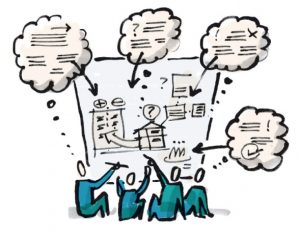bikaBLOG
All posts

From Visual Vocabulary to Key Visual: Playfully Combining Pictograms
By combining different elements of visual vocabulary, you can develop your own visual language. If you take a playful approach to this, you will often come up with unusual visual translations of the topic under discussion.

“Bikablorize” Images – A Guide to Creating Visuals in Five Simple Steps
In this short tutorial, we will show you how to “bicabloize” your own image motifs – i.e. reduce them to their essentials – using the bikablo technique for visualization.

Rules for Visualization – Part 2: Ten Beliefs that You Should Toss Out the Window
Meaning, discernment, and the fascinating relationship between words and images: Which beliefs you should toss out the window in order to make it easier to use visual language. (Continuation)

Sketchnoting in Dialogue – Part 2: Using Sketches in Business Conversations
Anyone can, by visualizing business processes, enable solutions to complex problems to be developed – by Sketchnoting Dialogues! Three steps can aid you in doing this.

Visual Feedback: a Second Channel of Communication
If there is a lack of mutual understanding, visualization opens a second channel of communication, and immediately, people begin to better understand each other’s point of view.

Sketchnoting in Dialogue – Part 1: Using Sketchnotes to Cut Through Complexity
“thought sketching” helps you to analyze everyday problems, arrive at informed opinions, and gain clarity about the situation at hand: How thinking with the pen helped us to decide about proper office rooms.